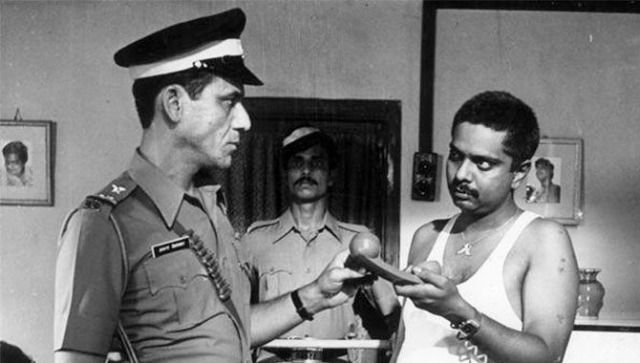February 2, 1983 9 am Ardh Satya, Scene 103 Location: Shivanand Shetty’s flat Shivanand Shetty is one of the four producers of Ardh Satya. Doesn’t talk much. Sometimes during the shooting, he’s seen standing on one corner of the set, without making any noise. Shetty’s flat is on a high-rise building in the backyard of Dadar-Portuguese Church. Shivanand Shetty’s flat becomes Rama Shetty’s flat in the film. He is a rather successful politician now, he is surrounded by luxury and opulence. His flat is spacious, well-equipped. A far cry from the dark hovel that his earlier den was. As the bell rings, the help answers the door. Anant Welankar enters. They have met before in very different circumstances. Rama Shetty leads him in. They sit in adjoining sofas. Anant is here to ask for Shetty’s help, much as it kills him to do so. He is suspended for killing a young man in custody, and only Rama Shetty can intervene and get the suspension order canceled. “Matlab ye ki iss lafde mein se salaamat chhootne ka hai tumko, hai na? Lekin ye asaan nahi, Welankar. Civil liberties waalon ne matter uthaya hai…” “Cut!” says Govind Nihalani, director of the film, and approaches the young actor named Sadashiv Amrapurkar who plays Rama Shetty. Govind asks him to emphasize certain words in his dialogue, adding that Sadashiv was doing brilliantly. His pose, his poise were just pitch-perfect. Sadashiv nails the rest of the dialogue. Rama Shetty insists that Anant be his “apna aadmi” within the police force. Anant Welankar, already at the brink of his endurance, blows off his top at what this parasite of a man dared to insist. He cannot be Rama Shetty’s lapdog - the audacity! Incensed, Anant pounces on Shetty and starts strangulating him. The shot gets okayed, but before the shot they had to rehearse the strangulation scene twice. Three times back to back, Sadashiv Amrapurkar dies and comes back to life. This happens over and over again, and Amrapurkar does it with panache every time. He was made to wear a locket, which breaks during the commotion of the first take. As the locket was getting fixed, Govind Nihalani completed another rehearsal. Sadashiv Amrapurkar’s neck was under a lot of pressure (being strangulated by a method actor is no fun). He asks for water, takes a generous sip and says, “Let’s do this in one take!” And that’s what happened. Perfect shot. Anant Welankar had killed Rama Shetty. *** The above account is a rough translation from a portion of Shrikrishna Damodar Panwalkar’s Marathi book “Shooting”. The book contains a shot by shot record of how Ardh Satya was made. The film was an official adaptation of Panwalkar’s short story Surya, and he had convinced Govind Nihalani that he should be allowed to be on the sets and compile all the goings-on in the form of a book. And that book became “Shooting”. Panwalkar’s story Surya provided the germ of Ardh Satya. The story didn’t have a goon called Rama Shetty, and nor did it have Anant Welankar’s incessant run-ins with the system. It is the story of a father and his son. Anant’s father was a cop and is hell-bent on making his son join the force too. But that’s the last thing on Anant’s mind. He is in love with Jyotsna Gokhale from college. They played badminton together. He didn’t want to be a police officer but didn’t have the courage to stand up to his domineering father. He grew up watching him order his mother around, and felt helpless. As he unwillingly dons the uniform, Anant drifts away from everyone. He indulges in smoking and drinking. Finally, one day when his father visits him, Anant unleashes all the pent-up rage and lets out a volley of insults. The story ends with him waking up to find his father sleeping on the floor. As the sun rises, Anant pulls a blanket over his father’s face. This poignant but rather tame story eventually morphed into the rage-filled saga called Ardh Satya. All the politics and violence that one sees in the film comes from the keen mind of Vijay Tendulkar. Vijay Tendulkar’s meditations on violence are well known. From Sakharam Binder to Shantata! Court Chalu Aahe, all his plays are filled with either implicit or explicit violence. He infused Ardh Satya with both. It was Tendulkar who introduced Govind NIhalani to S.D. Panvalkar’s collection of Marathi short stories called Surya. Nihalani read the translation, and the first story in the book, also called Surya, attracted his attention. As the decision to make a film on the idea took shape in his mind, Tendulkar built a superstructure around the basic storyline. Anant Welankar was placed in the turbulent Bombay of the early 80s, with political violence, labour unrest and corruption at their peak. The abusive father was present, but more fleshed out and more misogynistic. Jyotsna was a more etched out and richer character, someone who gladly shows a mirror to Anant, while being the only one in his life who understands his agony. And Rama Shetty walked in, straight out of oblivion.
The amazing Sadashiv Amrapurkar was born on this day, 72 years ago. On the occasion, Amborish Rochoudhury recounts some stories around Ardh Satya and Sadashiv’s breakout role, Rama Shetty.
Advertisement
End of Article


)
)
)
)
)
)
)
)
)



